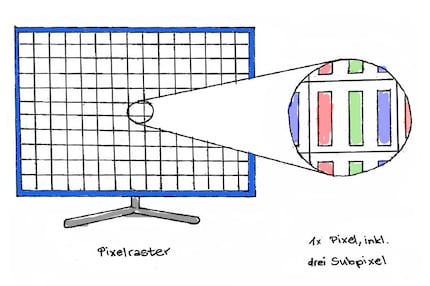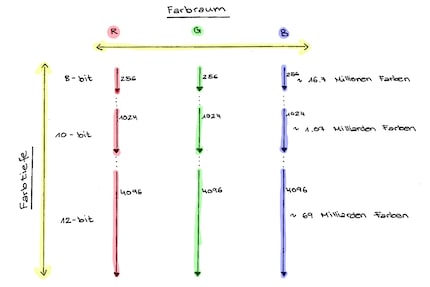
Background information
All fooled by the 4K scam
by Luca Fontana
When it comes to advertising, the number of pixels on the TV screen is the most important thing. Wrong. Colour reproduction and HDR are much more important.
First and foremost, manufacturers and retailers want to get their products to customers. There is nothing wrong with that: digitec also has to do well. Manufacturers are therefore constantly creating new trends. At the moment, it's the resolution. According to the motto: the higher the resolution, the better the picture.
In order to maximise sales, advertising is one of the most important tools. At the same time, advertising is omnipresent and annoying. Most of the time. That's why messages need to be short and concise.
"4K = better picture quality" is short. And it makes sense without in-depth explanations. Great, isn't it?
No. What bothers me is that manufacturers confuse for advertising purposes. But what bothers me even more is the fact that the number of pixels is irrelevant. The way a TV displays colours is much more important.
The more colours that can be displayed, the more natural the picture looks. Of course, this means in accordance with the reality that the eye sees when it looks out of the window. But: Which and how many colours the eye can see can hardly be derived mathematically. The television lacks a camera lens with which it can capture reality. Colours in a television set are a number, not an actual colour. And they are defined within colour spaces.
Colour spaces define how colour information is transmitted in the video signal. This is the case with TVs: the screen consists of several million pixels that together create the image. A pixel consists of three sub-pixels - red, green and blue. The colour of the pixel is a mixture of these three primary colours. This is why the RGB colour space is used in the video sector.

The number of gradations per colour channel depends on the colour depth. The depth is specified in bits. Bits are data that represent a value. In computer language, this is always a "0" or a "1". 8 bits means that each colour is assigned to a number with 8 digits, where each digit is a zero or a one.
In concrete terms: With 8-bit, each colour is assigned to a number between 00000000 and 11111111. This makes 2⁸ possible colour combinations per colour channel (2 times 2 times 2 times 2...), i.e. 256 colours each. In the RGB colour space, there are three channels, so the total number of colours corresponds to 256³ (256 times 256 times 256) - a total of 16.7 million colours.

Blu-Rays and normal live TV are in the 8-bit range. A UHD Blu-ray essentially covers the same colour space, but with a colour depth of 10 bits. This results in 1.07 billion colours. On the streaming platforms Netflix and AppleTV, and perhaps others, you will find content that is encoded with a colour depth of 12 bits. That makes 69 billion possible colours.
Simply put: the greater the colour depth, the more colours can be displayed. HDR televisions are at least in the 10-bit range.

Graphically, the colour space represents a specific range of displayable colours in a two-dimensional graphic - based on a predefined brightness.
In the past, televisions reached a peak brightness of around 100 nits. Nit is a unit for measuring brightness. One hundred nit is about as bright as the moon is at night. And it corresponds to a contrast range of around 1:100, which is SDR (Standard Dynamic Range). SDR is not enough to cover all colours in a 10-bit colour space.
This is where HDR comes into play. The aim is to expand the contrast range in order to be able to display more colours. Contrast essentially describes the difference between the darkest and the brightest pixel.
Tvs can increase the contrast in two ways:
OLEDs rely on variant two. This is due to the way they work: OLED pixels can switch on and off like a lamp when required. This makes the darkest black possible - also known as true black.
LCD pixels cannot do this. Although they block LED backlighting, a little light still gets through; with LCD televisions, black is more of a very dark grey. On the other hand, LEDs shine much brighter than the organic light-emitting diodes of OLED televisions. LCD TVs therefore increase their contrast range via variant 1.
The problem with high peak brightness: Colours fade. HDR does not stand for pale colours. The two-dimensional model of the colour space based on a predefined brightness is no longer sufficient. To calibrate colours in image and video files correctly, a third dimension is needed: brightness.

With brightness comes a new concept: the colour volume. It is the range of all displayable colours - colour space and colour depth - in all their brightnesses. In other words: A TV with 100% colour volume is able to reproduce all colours in the predefined colour space without them fading, even at peak brightness levels of 2000 nits. Samsung's QLED televisions are pretty good at this.
Despite marketing efforts, pixel mass alone says nothing about image quality. With more pixels, the picture is sharper, but to really get something out of it, the minimum seating distance must be maintained. This is very close to the TV.
The colour reproduction, on the other hand, determines how natural and real the picture looks. It is therefore much more important than the resolution in pixels. What's more, this is where the greatest progress has been made over the past ten years.
Summarised: The more colours your TV can display, the more natural the picture looks. The higher the contrast range, the more details are visible in bright or dark areas of the picture. A high resolution is important if you have a large TV or are sitting far away from it. However, if you do not maintain the minimum viewing distance, the HD effect will quickly fizzle out. Colour reproduction, on the other hand, is independent of the distance between you and the TV.
I write about technology as if it were cinema, and about films as if they were real life. Between bits and blockbusters, I’m after stories that move people, not just generate clicks. And yes – sometimes I listen to film scores louder than I probably should.
Interesting facts about products, behind-the-scenes looks at manufacturers and deep-dives on interesting people.
Show all